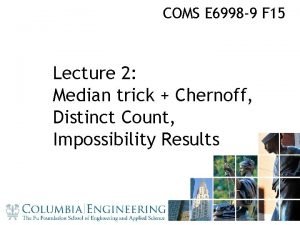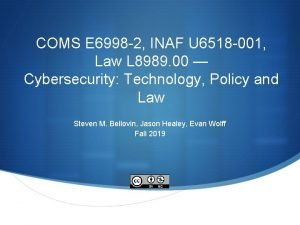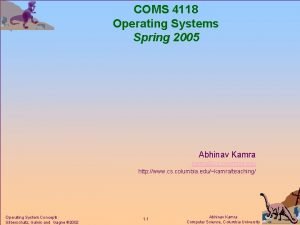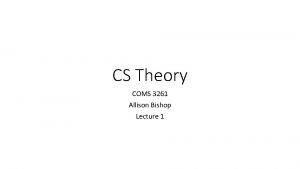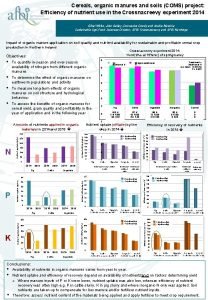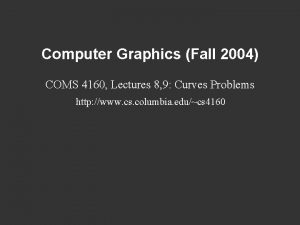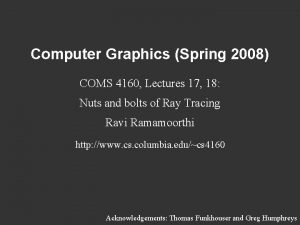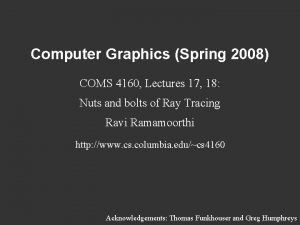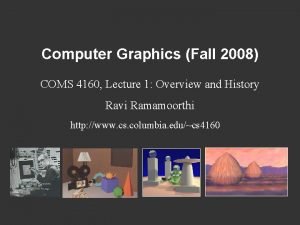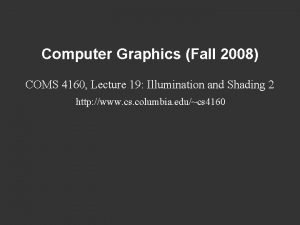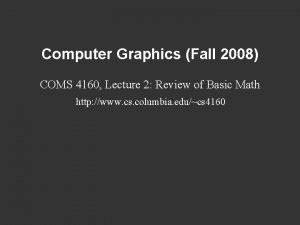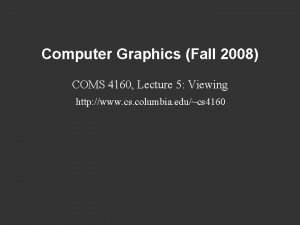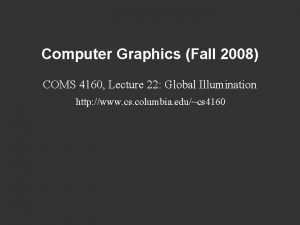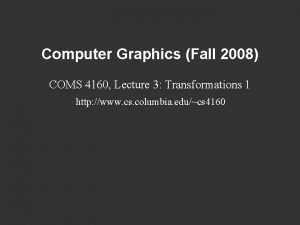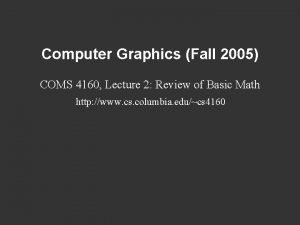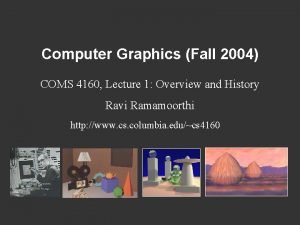Computer Graphics Fall 2008 COMS 4160 Lectures 8












- Slides: 12

Computer Graphics (Fall 2008) COMS 4160, Lectures 8, 9: Curves Problems http: //www. cs. columbia. edu/~cs 4160

To Do § Making progress on HW 2? § Any questions or issues? § Find partners for HW 3 and HW 4 § Remember though, that HW 2 is done individually § Your submission of HW 2 must include partner for HW 3

About this session § Review session for unit 2: curves § Such sessions for all units § Unit 1 later, closer to midterm due to time constraints § Go over problems similar to midterm, written § (Mostly) done on blackboard; problems PDF online Motivations § Technical issues and problems not fully covered in lecture § Chance for you to ask questions in more depth (we do have some problems to go over, but it’s also question-driven)

Questions? § Any issues with understanding curves material? § Implementing in HW 2? § General issues with course? § Questions regarding earlier part of course?

Problem 1 Consider a uniform quadratic B-spline. Consider a segment with control points (1, 0) (1, 1) and (0, 1) in that order. § What are the end-points of the curve segment? § What is the mid-point of the curve segment?

Answer 1 Consider a uniform quadratic B-spline. Consider a segment with control points (1, 0) (1, 1) and (0, 1) in that order. § What are the end-points of the curve segment? § What is the mid-point of the curve segment? Answer: LEFT (1, ½) MIDDLE (7/8, 7/8) RIGHT (½, 1)

Problem 2 Consider a uniform cubic B-spline. Consider a segment with control points (-1, -1) (-1, 1) (1, 1) and (1, -1) in that order. § What are the end-points of the curve segment? § What is the mid-point of the curve segment?

Answer 2 Consider a uniform cubic B-spline. Consider a segment with control points (-1, -1) (-1, 1) (1, 1) and (1, -1) in that order. § What are the end-points of the curve segment? § What is the mid-point of the curve segment? Answer: LEFT (-2/3, 2/3) MID (0, 11/12) RIGHT (2/3, 2/3)

Problem 5 Consider the problem of using a Bezier curve to approximate a circle. There exist efficient algorithms to draw Bezier curves, so it is often convenient to reduce other primitives to them. Because of symmetry in a circle, we will consider only the positive quadrant, i. e. with arc endpoints (1, 0) and (0, 1). What are the control points of a quadratic Bezier curve that best approximates the quarter circle? In particular, the end-points and tangents at those end points of the approximating Bezier curve must match those for the quarter circle. What is the maximum error in this approximation, i. e. the error at the mid-point of the Bezier curve?

Answer 5 Consider the problem of using a Bezier curve to approximate a circle. There exist efficient algorithms to draw Bezier curves, so it is often convenient to reduce other primitives to them. Because of symmetry in a circle, we will consider only the positive quadrant, i. e. with arc endpoints (1, 0) and (0, 1). What are the control points of a quadratic Bezier curve that best approximates the quarter circle? In particular, the end-points and tangents at those end points of the approximating Bezier curve must match those for the quarter circle. What is the maximum error in this approximation, i. e. the error at the mid-point of the Bezier curve? Answer: (1, 0) (1, 1) (0, 1) Maximum error is 0. 06

Problem 6 Both Bezier and B-spline curves are polynomials. Given any actual curve segment, it can be written as either a Bezier or a B -spline curve of the same degree, but with different control points. First, for a Bezier curve with control points (1, 0) (1, 1) and (0, 1), find the corresponding B-spline control points. Second, for a B-spline curve with control points (1, 0) (1, 1) and (0, 1), find the Bezier control points.

Answer 6 Both Bezier and B-spline curves are polynomials. Given any actual curve segment, it can be written as either a Bezier or a B -spline curve of the same degree, but with different control points. First, for a Bezier curve with control points (1, 0) (1, 1) and (0, 1), find the corresponding B-spline control points. Second, for a B-spline curve with control points (1, 0) (1, 1) and (0, 1), find the Bezier control points. Answer: Bezier is non-uniform B-spline. Bezier control points are (1/2, 1) (1, 1/2)



